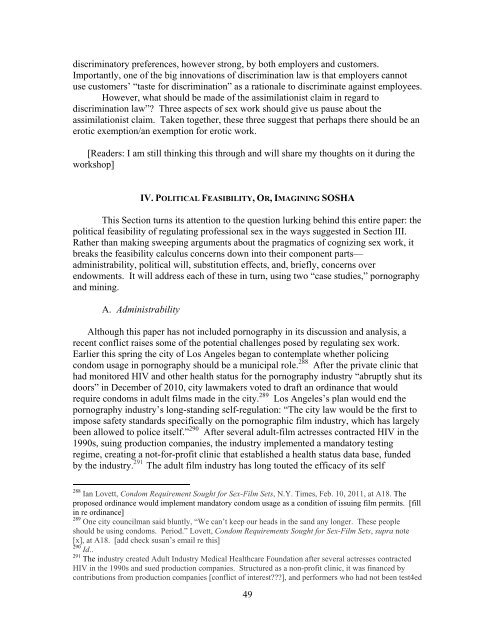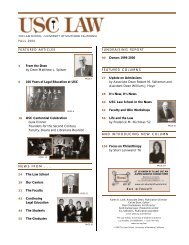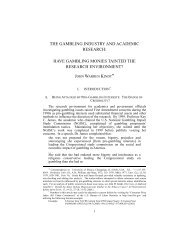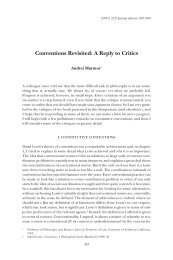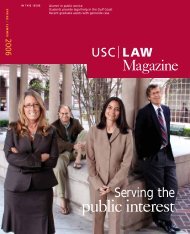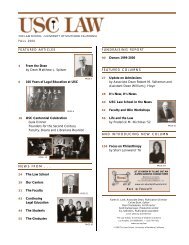1 Regulating Sex Work Adrienne D. Davis VERY ROUGH DRAFT ...
1 Regulating Sex Work Adrienne D. Davis VERY ROUGH DRAFT ...
1 Regulating Sex Work Adrienne D. Davis VERY ROUGH DRAFT ...
You also want an ePaper? Increase the reach of your titles
YUMPU automatically turns print PDFs into web optimized ePapers that Google loves.
discriminatory preferences, however strong, by both employers and customers.<br />
Importantly, one of the big innovations of discrimination law is that employers cannot<br />
use customers’ “taste for discrimination” as a rationale to discriminate against employees.<br />
However, what should be made of the assimilationist claim in regard to<br />
discrimination law”? Three aspects of sex work should give us pause about the<br />
assimilationist claim. Taken together, these three suggest that perhaps there should be an<br />
erotic exemption/an exemption for erotic work.<br />
[Readers: I am still thinking this through and will share my thoughts on it during the<br />
workshop]<br />
IV. POLITICAL FEASIBILITY, OR, IMAGINING SOSHA<br />
This Section turns its attention to the question lurking behind this entire paper: the<br />
political feasibility of regulating professional sex in the ways suggested in Section III.<br />
Rather than making sweeping arguments about the pragmatics of cognizing sex work, it<br />
breaks the feasibility calculus concerns down into their component parts—<br />
administrability, political will, substitution effects, and, briefly, concerns over<br />
endowments. It will address each of these in turn, using two “case studies,” pornography<br />
and mining.<br />
A. Administrability<br />
Although this paper has not included pornography in its discussion and analysis, a<br />
recent conflict raises some of the potential challenges posed by regulating sex work.<br />
Earlier this spring the city of Los Angeles began to contemplate whether policing<br />
condom usage in pornography should be a municipal role. 288 After the private clinic that<br />
had monitored HIV and other health status for the pornography industry “abruptly shut its<br />
doors” in December of 2010, city lawmakers voted to draft an ordinance that would<br />
require condoms in adult films made in the city. 289 Los Angeles’s plan would end the<br />
pornography industry’s long-standing self-regulation: “The city law would be the first to<br />
impose safety standards specifically on the pornographic film industry, which has largely<br />
been allowed to police itself.” 290 After several adult-film actresses contracted HIV in the<br />
1990s, suing production companies, the industry implemented a mandatory testing<br />
regime, creating a not-for-profit clinic that established a health status data base, funded<br />
by the industry. 291 The adult film industry has long touted the efficacy of its self<br />
288 Ian Lovett, Condom Requirement Sought for <strong>Sex</strong>-Film Sets, N.Y. Times, Feb. 10, 2011, at A18. The<br />
proposed ordinance would implement mandatory condom usage as a condition of issuing film permits. [fill<br />
in re ordinance]<br />
289 One city councilman said bluntly, “We can’t keep our heads in the sand any longer. These people<br />
should be using condoms. Period.” Lovett, Condom Requirements Sought for <strong>Sex</strong>-Film Sets, supra note<br />
[x], at A18. [add check susan’s email re this]<br />
290 Id..<br />
291 The industry created Adult Industry Medical Healthcare Foundation after several actresses contracted<br />
HIV in the 1990s and sued production companies. Structured as a non-profit clinic, it was financed by<br />
contributions from production companies [conflict of interest???], and performers who had not been test4ed<br />
49


